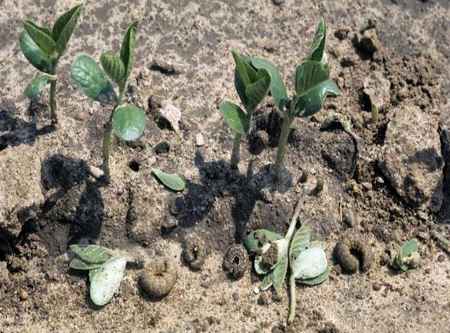Figure 1. Black cutworm caterpillar.
Injury to Soybeans
Black cutworm caterpillars feed on plant tissues close to the soil surface; caterpillars prefer to not climb plants. Stand reduction occurs when caterpillars become large enough to cut plants at the base (Figure 2).

Figure 2. Black cutworm caterpillars cut soybean plants near the soil surface.
Scouting
Scouting for black cutworm is difficult because caterpillars are nocturnal and hide during the day. Therefore, scouting revolves around finding soybean plants with signs of caterpillar feeding either on the leaves, around the base of the stem, or the presence of cut plants. Scouting should begin at emergence (VE) and continue weekly. Watch for areas with stand reduction as this may be an indicator of black cutworm activity. An insecticide treatment is recommended if greater than 20% of soybean plants are cut or defoliated and any black cutworm caterpillars that are found are less than 1 inch in long.
Management
Therapeutic management of black cutworm used in conjunction with scouting for feeding injury and caterpillars is also effective. Currently registered insecticides for management of black cutworm in soybean are listed in the current edition of the South Dakota Pest Management Guide: Soybeans. Because cutworms are nocturnal and hide under debris and soil during the day, the timing of the treatment is very important to ensure adequate coverage.
Source : sdstate.edu